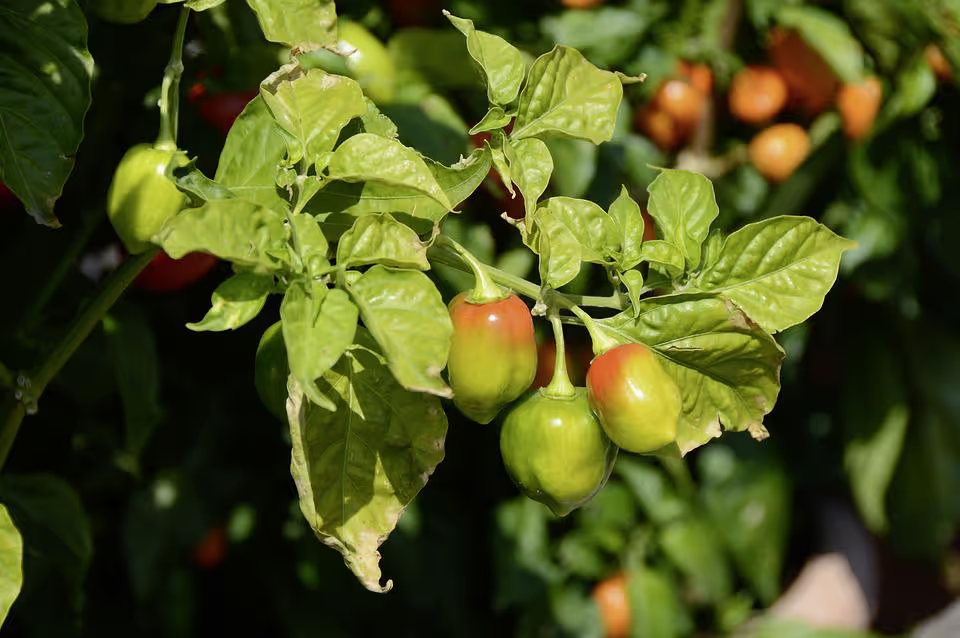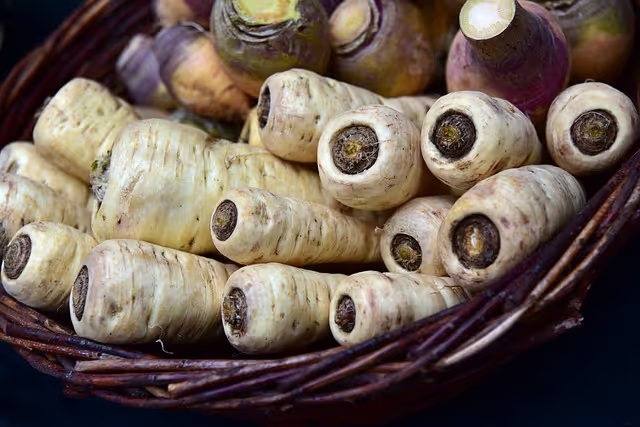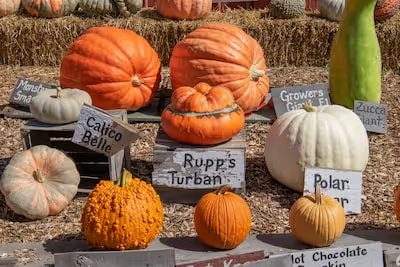Growing Jalapeno Peppers: How to Plant, Grow, and Harvest

Growing Jalapeno Peppers
Growing jalapeno peppers starts with selecting a sun-soaked spot where these fiery fruits can thrive—at least six full hours daily are required. Transplant sturdy seedlings after the threat of frost passes, spacing them 12 to 18 inches apart into fertile, well-draining soil mixed generously with compost. Feed regularly, water consistently without soaking, and you'll soon be picking jalapenos worthy of homemade salsa or fiery grilled poppers—keep reading for more tips on growing jalapeno peppers that pack a flavorful punch.
Cheatsheet: Jalapeno Pepper Growing Essentials
🌱 Start Seeds Indoors
- Sow 8-10 weeks before last frost (spring).
- Temperature: 75-85°F (24-29°C) for germination.
- Use seed trays, sterile mix, cover lightly.
- Keep soil moist, not wet.
☀️ Transplant Outdoors
- Move seedlings after danger of frost, when night temps stay above 55°F (13°C).
- Choose full sun, rich well-drained soil.
- Space plants 18 in (45 cm) apart, rows 24 in (60 cm).
💧 Care & Growth
- Water deeply, 1-2 in (2.5-5 cm) weekly.
- Mulch to conserve moisture, suppress weeds.
- Fertilize with balanced organic mix at planting, then monthly.
- Stake tall plants to support heavy fruit.
🐞 Prevent Pests & Disease
- Monitor for aphids, spider mites, cutworms.
- Hand-pick or use insecticidal soap if needed.
- Rotate crops yearly to avoid soil-borne disease.
🌶️ Harvest & Storage
- Pick at 3-4 in (7-10 cm), glossy green or ripe red, 70-90 days after planting.
- Use scissors or pruners to avoid stem damage.
- Store fresh in fridge up to 2 weeks, or dry/freeze for long-term.
🛠️ Tools and Products You'll Need
- Seed trays or starter pots
- Jalapeno seeds
- Sterile seed starting mix
- Grow lights (if low natural light)
- Hand trowel
- Watering can or hose
- Pruners or sharp scissors
- Mulch
- Organic fertilizer
- Garden gloves (optional)
- Stakes/ties (for support)
💡 Pro Tips
- Capsaicin burns calories; peppers deliver vitamin C, A, and antioxidants.
- Self-sufficiency: 3 plants can supply a household all season.
- Peppers get hotter as they ripen to red.
- Companion plant with basil, carrots, or onions for best results.
-
Growing Jalapeno Peppers: seed to salsa
I start seeds 8 to 10 weeks before my last frost, and I keep the tray at 80 to 85 F (27 to 29 C) for fast, even germination.
A heat mat and a bright LED at 4 to 6 inches (10 to 15 cm) above the canopy give me tight internodes and stocky transplants.
I prime old seed for 12 hours in a weak chamomile tea, then sow 2 per cell at 0.25 inches (6 mm) deep in a peat-free, fine mix.
Germination usually lands in 7 to 14 days, and I thin to the strongest seedling with scissors to avoid root disturbance.
“Pepper seed germination peaks near 86 F and drops sharply below 70 F.” Source: New Mexico State University, Chile Pepper Institute
Site, soil, and bed prep
I wait until nighttime air holds above 55 F (13 C) and soil sits at 65 F (18 C) at 3 inches (7.5 cm), then I plant.
Full sun means 8+ hours direct light, and peppers repay warm soil with earlier flowering and thicker walls.
My best results come from loamy soil with pH 6.2 to 6.8 and 3 to 5 percent organic matter.
I blend in 1 to 2 inches (2.5 to 5 cm) of compost and a balanced pre-plant like 4-6-3 at label rates, then water in with a mild kelp solution.
“Capsicum annuum performs best at soil pH 6.0 to 6.8 and consistent moisture.” Source: University of California ANR
Transplanting and spacing
I harden plants for 7 to 10 days, nudging them outdoors a bit longer each day while cutting water slightly to firm tissue.
Spacing that breathes is everything: 14 to 18 inches (35 to 45 cm) between plants and 24 to 30 inches (60 to 75 cm) between rows.
I bury stems to the first true leaves in fluffy ground to anchor, and I install a stake at planting so roots grow around it.
A floating row cover over hoops for the first 2 weeks boosts heat, blocks wind, and deflects early aphids.
Containers that crank
In pots, 5 gallons (19 L) is the floor and 10 gallons (38 L) is luxury, filled with a chunky mix heavy on composted bark and perlite.
Container peppers feed and drink like athletes, so I fertigate lightly every 7 to 10 days once flowering starts.
Fertility that grows fruit, not leaves
I aim for modest nitrogen and steady potassium and calcium once buds appear, or I get a jungle and few pods.
A simple program: pre-plant organic 4-6-3, then side-dress 1 tablespoon per plant at first fruit set and again 3 weeks later, or feed 150 to 200 ppm N via fertigation in soilless mixes.
Overfeeding nitrogen stalls fruiting and invites soft growth, which mites love.
A soil test saves money and peppers, and I trust it over hunches every season.
Water, heat, and mulch
Peppers want even moisture, so I target 1 inch (25 mm) per week, more in hot, windy spells, and I water in the morning.
Two inches (5 cm) of straw or shredded leaves drops surface temps and shrinks swings that trigger blossom-end rot symptoms.
Flower drop spikes above 90 F (32 C), especially with hot, dry wind, so I clip 30 percent shade cloth during heat waves.
“Day temps above 90 F and nights above 75 F can reduce pepper fruit set.” Source: Texas A&M AgriLife Extension
Training, topping, and support
I top at 6 to 8 true leaves on early seedlings for branching in rich soil, then I let the plant choose leaders.
On heavy bearers like Jalafuego, I run a light Florida weave or single-stake tie every 8 inches (20 cm) to keep fruit off soil and stems off the ground.
Pollination and fruit set
Jalapenos self-pollinate, but airflow matters, so I keep foliage thinned inside the canopy and avoid spraying during midday bloom.
On still days in a tunnel, I tap stakes to shake pollen loose, a trick I learned from a seed grower who always out-yielded me.
Pests, diseases, and clean habits
Aphids, thrips, and spider mites ride in on weeds, so I keep borders mowed and scout the undersides of leaves with a hand lens.
At first sign, I knock them back with insecticidal soap, and I release predatory mites if weather cooperates.
Pepper weevil is a different beast in warm regions; I rotate far from nightshades, pick promptly, and use traps at field edges.
“Pepper weevil infestations can slash yields by 30 to 50 percent.” Source: University of Florida IFAS Extension
For diseases like bacterial leaf spot and Phytophthora blight, I lean on resistant varieties, clean transplants, good drainage, and copper only as a last resort.
I never irrigate overhead in the evening, and I sanitize pruners in 10 percent bleach between plants if I see spotty leaves.
Heat, flavor, and harvest timing
Jalapenos typically rate 2,500 to 8,000 Scoville Heat Units, and water stress plus high heat pushes the needle upward.
I pick green at 60 to 75 days for crisp texture, or I wait for red at 80 to 100 days for sweetness and smoke-worthy chipotles.
Corking, those tan stretch marks, signals fast growth and intense flavor, and markets in Mexico prize it.
I cut with snips, leaving a short stem to avoid tearing the calyx and opening a door to rot.
“Most capsaicin lives in the white placenta and crosswalls, not the seeds.” Source: NMSU Chile Pepper Institute
For storage, I hold fresh pods at 45 to 50 F (7 to 10 C) with 90 to 95 percent relative humidity for up to 2 weeks.
For long keeping, I smoke ripe reds low and slow to make chipotles, or I slice and freeze on a sheet pan before bagging.
Overwintering and seed saving
Peppers are short-lived perennials in frost-free zones, and I overwinter favorites by pruning to a small framework and parking them under bright light indoors.
I water sparingly, up-pot in spring, and they leap ahead of new starts by a month.
For seed, I select fully red, overripe fruit from a standout plant, then ferment the seeds in water for 48 hours to shed inhibitors.
I dry to cracker-crisp and stash in airtight jars with silica gel; stored cool and dry, jalapeno seed stays viable for 2 to 3 years.
Top jalapeno varieties I trust
- Early Jalapeno: fast to flower in cool springs, compact, bold flavor.
- Jalafuego F1: high yields, thick walls, handles heat stress gracefully.
- El Jefe F1: uniform pods for market trays, reliable in variable weather.
- Mucho Nacho F1: jumbo pods for poppers, medium heat.
- TAM Jalapeno: bred for mild heat by Texas A&M, great for families.
- Felicity: near-zero heat, jalapeno flavor without the fire.
- NuMex Jalmundo: huge fruits from the Chile Pepper Institute, smoke beautifully.
- Traveler Jalapeno: sturdy plants that shrug off wind in raised beds.
I rotate two or three of these each year to spread risk and keep flavor interesting.
Seed houses list days to maturity and disease notes, which helps match the right plant to your microclimate.
Buying guide: seeds, starts, and gear
Certified seed from reputable suppliers cuts disease risk, and disease-indexed transplants help if your season starts late.
A basic kit that pays back: a seedling heat mat, domed tray, full-spectrum LED, soil test, pH meter, and 30 percent shade cloth.
For containers, I like breathable fabric pots, a slow-release organic fertilizer, and a calcium source if your water runs soft.
For field beds, drip tape on a timer with a simple filter keeps foliage dry and scheduling sane.
Companions and rotation
I tuck basil, scallions, and marigolds nearby for pollinators and mild pest pressure reduction.
I rotate away from tomatoes, eggplants, and potatoes for 3 years to break disease cycles and to sidestep soil fatigue.
Troubleshooting quick hits
- Pale leaves and slow growth: feed lightly with a balanced product and check root health.
- Leaf curl and stippling: suspect spider mites; hit early with soap or predatory mites.
- Flowers dropping: heat stress or swings; add shade cloth and steady water.
- Sunscald patches: increase leaf cover or add temporary shade on west side.
- Soft, black tips: classic blossom-end rot symptoms; even moisture and adequate calcium availability fix it.
- Corking on pods: cosmetic and flavorful; sell the story and enjoy the taste.
Yields and timelines you can bank on
With good care, a plant throws 25 to 50 pods, often 3 to 5 pounds (1.4 to 2.3 kg) per season in warm zones.
Peak sets arrive in waves 3 to 4 weeks apart, and picking clean and often keeps the conveyor belt running.
Flavor notes from the field
Jalapenos grown slightly lean, mulched, and picked just as the first red streaks appear hit a sweet-heat balance that sings in pico.
I salt them over charcoal for a minute, then finish with lime and oil, and they taste like summer got bottled.
“Hot peppers are rich in vitamin C, often exceeding 100 mg per 100 g.” Source: USDA FoodData Central
Frequently Asked Questions about Growing Jalapeno Peppers
When is the best time to plant Jalapeno peppers?
Jalapeno peppers prosper best when sown indoors 6-8 weeks before the last frost date in your region. After the threat of frost passes and nighttime temperatures stay consistently above 55°F (13°C), transplant seedlings outside to thrive.
What type of soil do Jalapeno peppers require?
These peppers favor well-draining, nutrient-rich soils with a pH between 6.0 and 6.8. Incorporate organic matter like compost or aged manure into your soil to support vigorous root development and healthy plant growth.
How far apart should Jalapeno peppers be spaced?
Provide each Jalapeno pepper plant with adequate growing room by spacing them 18-24 inches (45-60 cm) apart in rows separated by 24-36 inches (60-90 cm). This spacing encourages proper air flow, reducing disease and pest risks.
How much sunlight do Jalapeno pepper plants need?
Jalapeno plants require full sun exposure, receiving at least 6-8 hours of direct sunlight daily. Optimal sunlight levels boost pepper yield and flavor intensity.
How often should Jalapeno peppers be watered?
Regular watering is beneficial, typically providing around 1-2 inches (2.5-5 cm) of water per week. Allow the soil surface to dry slightly between watering sessions. Consistent moisture without overwatering ensures healthy plant growth and prevents rot.
Should Jalapeno pepper plants be fertilized?
Yes, applying a balanced, slow-release fertilizer periodically during the growing season will nourish your Jalapeno pepper plants. Select a fertilizer with a NPK ratio of 5-10-10 or similar to encourage hearty fruit production and foliage health.
When are Jalapeno peppers ready for harvest?
Jalapenos are typically ready to pick 70-85 days after transplanting, once the peppers measure approximately 2-3 inches (5-7.5 cm) in length, feel firm, and display a vibrant green color. Allowing them additional time to ripen further increases sweetness and heat intensity.
Growing Jalapeno Peppers rewards patience and pays off in bold, homegrown flavor. Start with rich soil, steady warmth, and consistent watering. Give your plants sunlight, watch for pests, and support heavy branches when the fruit sets. Harvest when the peppers are glossy and firm—don’t wait too long, or you’ll lose that perfect heat. With a bit of care, your harvest will pack the punch you’re after. And if you want to explore more unique crops, try your hand at growing azuki beans or experiment with nasturtiums for a splash of color and spice. In the end, growing jalapeno peppers is about savoring the simple, fiery joys of your own backyard.
Pro Tips: Boost Your Jalapeno Pepper Yield Naturally
Companion Planting Partners
- Basil and oregano: Attract beneficial insects that repel pests and enhance pepper flavor.
- Marigolds and nasturtiums: Deter aphids and whiteflies while improving soil health.
- Beans and peas: Fix nitrogen in soil, improving pepper vigor and productivity.
Optimal Soil Amendments
- Worm castings: Increase microbial activity for stronger roots and improved pepper yield.
- Epsom salts (magnesium sulfate): Apply monthly—2 tablespoons (30 g) per gallon (4 liters) water—for stronger growth and prolific flowering.
- Crushed eggshells: Sprinkle around stems to deter slugs and add calcium, preventing pepper blossom-end rot.
Strategic Pruning Practices
- Remove early blossoms until plants reach at least 12 inches (30 cm) to encourage vigorous growth.
- Pinch lower leaves gradually to improve airflow and reduce fungal disease.
- Thin crowded branches regularly for sunlight penetration, ensuring even ripening.
Targeted Watering Techniques
- Water deeply once weekly at soil level; avoid superficial moisture to promote deep root establishment.
- Apply mulch—straw or shredded bark—2 inches (5 cm) thick to retain soil moisture, maintain consistent temperature, and suppress weeds.
Harvesting for Continued Production
- Pick peppers promptly upon maturity—3 to 4 inches (7.5 to 10 cm)—to encourage continual flowering and fruit production.
- Handle peppers gently; damaged fruits release stress hormones affecting subsequent yields.
Leveraging Nutritional Benefits
- Jalapenos deliver vitamins A, C, and potassium; regular consumption supports immune function and heart health.
- Capsaicin, the spice component, promotes metabolism and provides anti-inflammatory, antioxidant properties.
Find out which plants will thrive in your garden!
Answer a few fun questions and get custom plant recommendations perfect for your space. Let’s grow something amazing together!

start your season





